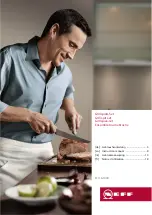
7
STEP 1.
Turn the Grill Control Knobs to the “OFF” position.
(FIG. 15A)
STEP 2.
Remove the protective cap from the cylinder gas
nozzle. Keep it for re-capping.
STEP 3.
Hook the 20 lb. Cylinder upright to the hanger on the
right side. Connect end of hose to Cylinder valve by turning
counter-clockwise and hand tighten.
(FIG.16A)
STEP 4.
Run the other end of the hose under the Leg shelf
behind the leg. Grasp and hold the regulator with one hand.
Push the hose end into the regulator nipple and turn the
knurled knob clockwise.
(FIG. 16B)
Make sure the connection
does not cross thread. Hand tighten to a snug connection.
Do not use tools.
To Disconnect the cylinder:
STEP 1.
Turn the Grill Control Knobs to the “OFF” position.
STEP 2.
Disconnect end of hose to Cylinder valve by turning
clockwise.
STEP 3.
Re-cap the cylinder.
FIG. 16A
FIG. 16B
LP Cylinder
Hanger
· If an external electrical source is utilized, the outdoor
cooking appliance, when installed, must be electrically
grounded in accordance with local codes or, in the
absence of local codes, with the
National Electrical
Code, ANSI/NFPA 70
, or the
Canadian Electrical Code
CSA C22.1.
· Keep any electrical supply cord away from any heated
surfaces.
To reduce the risk of serious bodily injury or death:
· This outdoor cooking appliance shall be used only
outdoors and shall not be used in a building, garage,
or any other enclosed area. Locate outdoor cooking
appliance in an area with good ventilation on a level
stable surface clear of combustible and flammable
material.
· Maintain minimum clearances of 36” from back and
sides of grill to any combustible construction.
· Do not locate this appliance under overhead
unprotected combustible construction.
· This outdoor cooking appliance is not intended to be
used in or on boats or installed in or on recreational
vehicles.
· Do not use gas grill as a space heater.
Selecting a Location
Connecting/Disconnecting 20 lb. LP Cylinder
Performing a Leak Test
To reduce the risk of serious bodily injury or death:
· Perform a leak test before each use and each time a
gas connection or disconnection is done .
· Perform a leak test in a well ventilated area.
· Never use an open flame to test for gas leaks.
· Never smoke near the grill during a leak test.
· Do not perform a leak test on a grill while it is hot or in
use.
· Do not use the gas grill if you detect a gas leak that
cannot be corrected by using the leak test procedures.
OPERATING YOUR GAS GRILL
To reduce the risk of serious bodily injury or death:
· This installation must conform with local codes or, in
the absence of local codes, with either the
National
Fuel Gas Code, ANSI Z223.1/NFPA 54 Natural Gas and
Propane Installation Code, CSA B149.1,
or
Propane
Storage and Handling Code, B149.2
or the
Standard for
Recreational Vehicles, ANSI A 119.2/NFPA 119
2 and
CSA Z240 RV Series, Recreational Vehicle Code,
as
applicable
Installation Codes
BEFORE USING YOUR LP GAS GRILL
How to perform a leak test: See leak test diagrams next
page.)
Supplies Needed for a Leak Test:
Clean paint brush, water,
and dishwashing liquid.
1) Mix 1-cup of water with one cup of dishwashing liquid.
2) Make sure all Control Knobs are in the “Off” position.
3) Remove the two Cooking Surfaces.
4) Pull the Control Knobs off the valve stems. Remove the
5-screws securing the Grid Insert Guide, Control Panel
and Chain and Match Holder. Lay parts aside. (
See
FIG. 23A page 12 )
5) If LP Cylinders are not already connected, attach them
according to above instructions for Attaching LP Gas
Cylinder to Regulator.


































